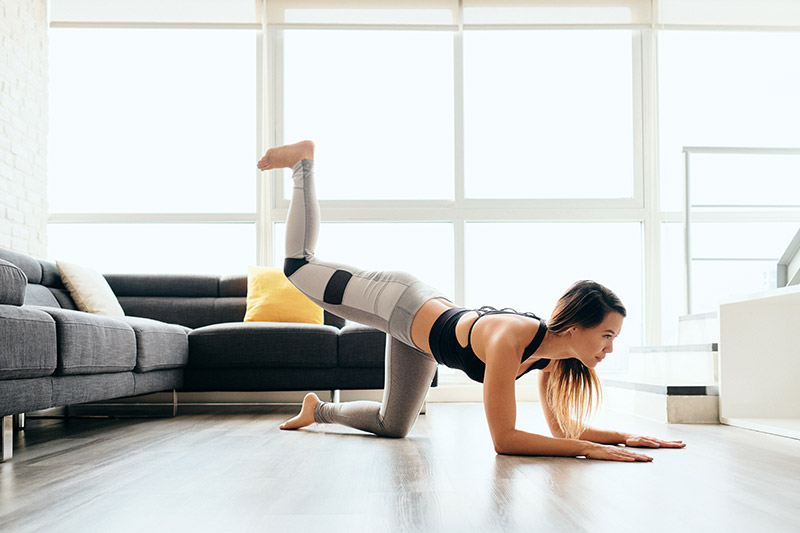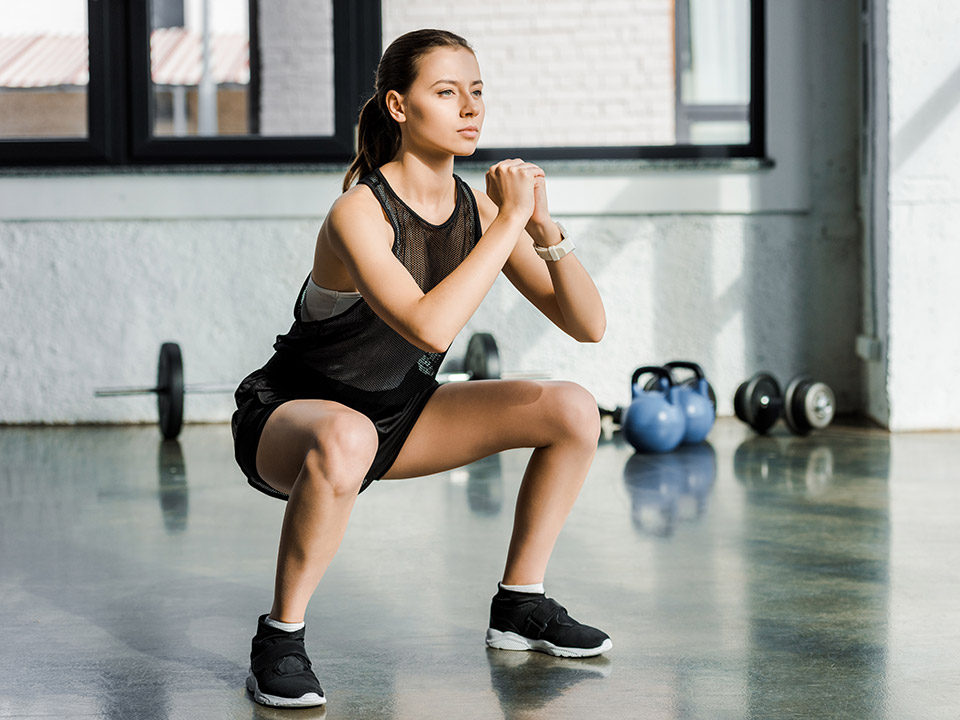The butt is a key part of your body, and it’s important to keep it strong and toned. There are many exercises that can help you do this, but the top 10 butt exercises are squats, lunges, donkey kicks, hip thrusters, step ups, glute bridges, fire hydrants, single-leg deadlifts, curtsy lunges and side-lying clam shells. Squats are one of the best butt exercises because they work your entire lower body in one move. Lunges also work your legs and glutes in an effective way. Donkey kicks target your glutes directly for a firmer butt. Hip thrusters work your glutes and hamstrings for extra power. Step ups target your glutes while also working on balance and coordination. Glute bridges involve lying on your back with your knees bent as you lift up your hips to activate those muscles in a powerful way. Fire hydrants will give you great results if done correctly. Single-leg deadlifts strengthen both sides of the lower body equally while also helping with balance, coordination and posture. Curtsy lunges are perfect for toning up the booty area while strengthening the legs at the same time. Side-lying clam shells complete this list by targeting the lateral muscle groups of the hips and glutes for an all-round stronger look!
Working on the butt muscles, also known as the glutes, is important for several reasons:
Improved posture: Strong glutes help to keep the pelvis and lower back in proper alignment, which can help to improve posture and reduce the risk of lower back pain.
Increased power and speed: The glutes are the primary muscle group responsible for hip extension, which is an important movement for activities such as running, jumping, and climbing stairs. Strong glutes can help to increase power and speed in these activities.
Better balance and stability: The glutes help to stabilize the pelvis and lower body during standing, walking, and other activities. Strong glutes can help to improve balance and stability, reducing the risk of falls and injuries.
Aesthetics: A toned and shapely butt can be considered an attractive and important aspect of overall body appearance.
Improved function: The glutes play a crucial role in many everyday movements such as walking, climbing stairs, rising from a seated position and getting up from a squatting position. Strong glutes can make these movements easier and more efficient.
Overall, working on the glutes can not only improve the appearance of your lower body but also improve your overall health and physical function.
Here is a step-by-step guide on how to properly perform each butt exercise.
Squats
- Stand with your feet hip-width apart and your toes pointing forward.
- Begin the squat by sitting back and down as if you were sitting into a chair. Keep your chest up and your back straight.
- Lower your body until your thighs are parallel to the ground or lower. Keep your weight in your heels, not your toes.
- Pause at the bottom of the squat, and then drive through your heels to push back up to the starting position.
- Repeat for desired number of repetitions.
Keep your chest up and avoid letting your knees cave inwards. It’s also recommended to use a weight that you can comfortably perform 8-12 reps with good form.
Lunges
- Stand with your feet hip-width apart and your hands on your hips.
- Step forward with one foot, and lower your body until your thigh is parallel to the ground and your knee is directly above your ankle.
- Push back up to the starting position by driving through the heel of the front foot.
- Repeat on the other leg.
You can also perform lunges in a walking motion, where you alternate legs as you step forward. Keep your chest up, and avoid letting your knee cave inwards. It’s also recommended to use a weight that you can comfortably perform 8-12 reps with good form.
Keep your chest up and avoid letting your knees cave inwards. It’s also recommended to use a weight that you can comfortably perform 8-12 reps with good form.
Deadlifts
- Stand with your feet hip-width apart and your toes pointing forward.
- Position the barbell over your mid-foot, and bend down to grab the bar with an overhand grip. Your hands should be just outside of your legs.
- Keep your back straight, and lift the bar by straightening your legs and lifting your hips towards the ceiling. Keep the bar close to your body as you lift it.
- Once you are standing up straight, pause and squeeze your glutes at the top of the movement.
- Lower the bar back down to the floor by bending at the hips and knees, keeping the bar close to your body.
Keep your back straight and avoid rounding your lower back. It’s also recommended to use a weight that you can comfortably perform 8-12 reps with good form. It’s also advisable to get proper guidance and supervision while performing deadlifts as it’s a complex exercise that requires proper form to avoid injury.
Glute bridges
- Lie on your back with your knees bent and your feet flat on the floor. Your arms should be by your sides.
- Drive through your heels and lift your hips up towards the ceiling. Keep your feet, knees and shoulders in contact with the floor throughout the exercise.
- Squeeze your glutes at the top of the movement and hold for a moment.
- Slowly lower your hips back down to the starting position.
- You can also perform Glute bridges with added weight, by holding a barbell or a dumbbell over your hips or even by adding leg extensions to the movement.
It’s important to use good form while performing Glute bridges, keep your core tight, and avoid arching your lower back. It’s also recommended to use a weight that you can comfortably perform 8-12 reps with good form.
Step-ups
- Stand in front of a step or bench, facing forward.
- Step up onto the bench or step with one foot, while keeping your other foot on the floor.
- Drive through the heel of the foot on the bench, and lift your body up onto the step. Keep your other foot on the floor.
- Step back down with the same foot, and repeat the movement on the same leg for the desired number of repetitions.
- Switch legs and repeat the process.
Keep your chest up and avoid letting your knee cave inwards. It’s also recommended to use a weight that you can comfortably perform 8-12 reps with good form. Additionally, you can also add dumbbells or barbells to increase the intensity of the exercise.
Hip thrusts
- Here is a step-by-step guide on how to properly perform a hip thrust:
- Sit on the floor with your back against a bench, with your knees bent and your feet flat on the floor.
- Place a barbell or a weight plate on your hips and position your upper back on the bench.
- Drive through your heels and lift your hips up towards the ceiling.
- Squeeze your glutes at the top of the movement and hold for a moment.
- Slowly lower your hips back down to the starting position.
Keep your core tight and avoid arching your lower back. It’s also recommended to use a weight that you can comfortably perform 8-12 reps with good form.
Clamshells
- Lie on your side with your legs bent at a 90-degree angle and your feet together.
- Keep your heels together and your feet touching as you lift your top knee as high as you can without moving your pelvis.
- Slowly lower your knee back down to the starting position.
- Repeat for the desired number of reps and then switch sides.
Keep your core tight and avoid arching your lower back. It’s also recommended to use a light weight or a resistance band to increase the intensity of the exercise.

Donkey kicks
- Start on all fours with your hands and knees on the ground.
- Keeping your knee bent, lift your right leg up and back towards the ceiling, squeezing your glutes at the top of the movement.
- Slowly lower your leg back down to the starting position.
- Repeat for the desired number of reps and then switch sides.
Keep your core tight and avoid arching your lower back. It’s also recommended to use a light weight or a resistance band to increase the intensity of the exercise.
Fire hydrants
- Start on all fours with your hands and knees on the ground.
- Keeping your knee bent, lift your right leg out to the side, keeping your foot flexed and squeezing your glutes at the top of the movement.
- Slowly lower your leg back down to the starting position.
- Repeat for the desired number of reps and then switch sides.
Keep your core tight and avoid arching your lower back. It’s also recommended to use a light weight or a resistance band to increase the intensity of the exercise.
Leg press
- Sit in the leg press machine and place your feet on the platform. Make sure your feet are hip-width apart and facing forward.
- Adjust the seat so that your knees are in line with your hips and your back is comfortably against the backrest.
- Release the safety lock and begin the exercise by pressing your feet against the platform, extending your legs and straightening your knees.
- Pause briefly at the top of the movement, and then lower the platform back to the starting position.
- Repeat for the desired number of reps.
Keep your back against the backrest and avoid arching your lower back. It’s also recommended to use a weight that you can comfortably perform 8-12 reps with good form. Additionally, you can also adjust the foot placement on the platform (narrow or wide) to target different muscle groups.
It’s important to use proper form and not to add too much weight too soon, to avoid injury. It’s also recommended to use a weight that you can comfortably perform 8-12 reps with good form.

